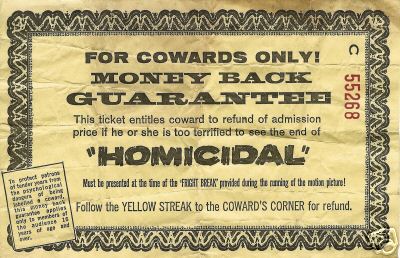It’s Better to Be Afraid than Embarrassed?
The 1961 horror film “Homicidal” isn’t going to make any list of must-watch movies. It’s not bad — it has an 80% rating on ten reviews on Rotten Tomatoes and averages 3.3 stars on Letterboxd over more than 1,600 reviews. One critic called the movie “an enjoyably bizarre film, making some of the basic elements of Psycho even freakier.” That sounds good, but the movie is not for everyone — plenty of people aren’t fans of “bizarre” or “freaky” films, after all, and may have found Homciidal scarier than they bargained for.
And while the same could be said for many horror films, Homicidal came with an insurance policy: if you were too scared, you could leave and get your money back. At least, at first.
Homicidal was directed by William Castle, a director of low-budget, B-list movies from the 1940s through the 1960s. He was probably best known for the 1959 screamer “The House on Haunted Hill,” starring Vincent Price; the movie made $2.5 million on a $200,000 production budget. To help get people in the seats, Castle came up with a creative marketing gimmick — a 3-D experience well before 3-D movies were an option. As summarized on Wikipedia, on Castle’s urging, “in some theaters that showed the film, exhibitors rigged an elaborate pulley system near the theater screen which allowed a plastic skeleton to be flown over the audience during a corresponding scene late in the film.” As word of the flying skeleton spread, so did interest in the movie, and the film became a commercial success.
For Homicidal, though, Castle had a different marketing stunt in mind: a ticket out. Just before the movie’s climax, a 45-second timer appeared on the screen. Patrons were told that this was the “Fright Break” — if, during that 45-second window, a viewer was too scared to continue watching, they could simply get up and leave the theater. If they did so, they could return to the box office and the theater would graciously refund their admission.
The idea worked a little too well, though. According to the book “Crackpot,” customers found a way to take advantage of the offer — they watched the whole movie but then stayed in the theater for a second showing. When the Fright Break popped up the second time around, they left, recouping their money. Castle cracked down on this by having theaters issue different colored tickets for different shows, but some customers tried the stunt and demanded refunds anyway. So Castle came up with another idea: embarrass those who decided to bow out.
Castle began to issue certificates like the one below to moviegoers. Yes, you could get your money back, but if you did, you’d be branded a coward.

And the ticket was just the beginning. Crackpot continues:
[Castle] came up with “Coward’s Corner,” a yellow cardboard booth, manned by a bewildered theater employee in the lobby. When the Fright Break was announced, and you found that you couldn’t take it any more, you had to leave your seat and, in front of the entire audience, follow yellow footsteps up the aisle, bathed in a yellow light. Before you reached Coward’s Corner, you crossed yellow lines with the stencilled message: “Cowards Keep Walking.” You passed a nurse [ . . . ] who would offer a blood-pressure test. All the while a recording was blaring, “Watch the chicken! Watch him shiver in Coward’s Corner!” As the audience howled, you had to go through one final indignity – at Coward’s Corner you were forced to sign a yellow card stating, “I am a bona fide coward.”
As one would imagine, very few people were willing to subject themselves to such an experience. And for the rest of the audience, the gimmick turned into a game: your ticket to the movie entitled you to watch the film, but also gave you a sporting chance at finding a coward to laugh at.
The stunt probably worked. According to the American Film Institute, after Castle created the Coward’s Corner, “theaters were taking in an average of $20,000 weekly, and only paying out $100 in refunds.” And, per some accounts, Alfred Hitchcock took notice of Homicidal — which gave him the inspiration to create Psycho a year later.
Bonus fact: As noted above, Homicidal isn’t making any top-25 lists. Case in point: In 2007, Time Magazine published its list of “top 25 horror movies” of all time and Homicidal isn’t on it. But guess what is? Yes, Psycho, Carrie, and the Texas Chain Saw Massacre make the list. But so does Bambi. The classic Disney film, per Time, earned a spot rather easily: “Parents disappear or die; stepmothers plot the murder of their charges; a boy skips school and turns into a donkey. Kids were so frightened by these films that they wet themselves in terror. Bambi, directed by David Hand, has a primal shock that still haunts oldsters who saw it 40, 50, 65 years ago.”
From the Archives: The Creepiest Way to Say Happy Birthday: Warning — there’s a scary clown behind that link.
